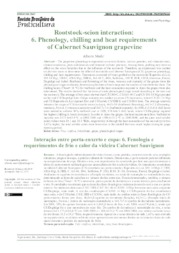Rootstock-scion interaction: 6. Phenology, chilling and heat requirements of Cabernet Sauvignon grapevine.
Rootstock-scion interaction: 6. Phenology, chilling and heat requirements of Cabernet Sauvignon grapevine.
Author(s): MIELE, A.
Summary: The grapevine phenology is dependent on several factors, such as genetics, soil characteristics, climate conditions, pests and diseases and vineyard cultural practices. Among these, grafting may have an effect on the scion behavior due to the influence of the rootstock. Therefore, an experiment was carried out for two years to determine the effect of rootstocks on Cabernet Sauvignon (CS) grapevine phenology, chilling and heat requirements. Treatments consisted of vines grafted on the rootstocks Rupestris du Lot, 101-14 Mgt, 3309 C, 420A Mgt, 5BB K, 161-49 C, SO4, Solferino, 1103 P, 99 R, 110 R, Gravesac, Fercal, Dogridge and Isabel. Budbreak and flowering of the vines, veraison and maturity of the grapes were the phenological stages evaluated, determining the dates of each stage and the number of days between them. The chilling hours (Tbase= 10 °C) for budbreak and the heat summation required to ripen the grapes were also determined. The results showed that the dates of each phenological stage varied according to the year and the rootstock. The average of two years showed that CS/3309 C, CS/161-49 C and CS/101-14 Mgt sprouted earlier and CS/Dogridge later. Grape maturity was earlier on seven CS/rootstocks, where CS/101-14 Mgt and CS/Rupestris du Lot ripened first and CS/Isabel, CS/5BB K and CS/SO4 later. The average intervals between the stages of CS/rootstocks were (in days), 46.8±3.0 (budbreak-flowering), 64.3±2.1 (flowering-veraison), 54.6±6.1 (veraison-maturity) and 165.7±7.4 (budbreak-maturity). In 1998, 615.9±8.0 chill hours were needed to achieve 50% budbreak and in 1999, 870.6±6.5 chill hours, where CS/Dogridge required the highest chilling to break dormancy. In order to ripen the grapes, the heat requirement from budbreak to maturity was 1573.4±43.0 °C in 1998/1999 and 1599.4±25.5 °C in 1999/2000, and the juice total soluble solids values were 19.1 and 18.1 °Brix, respectively. Although the heat summation of the second cycle was 1.65% higher, the total soluble solids were lower due to the rainfall that was much higher during its grape ripening period.
Publication year: 2019
Types of publication: Journal article
Unit: Embrapa Grape & Wine
Keywords: Grapes, Phenological stages, Viticulture, Vitis Vinifera
Observation
Some of Embrapa's publications are published as ePub files. To read them, use or download one of the following free software options to your computer or mobile device. Android: Google Play Books; IOS: iBooks; Windows and Linux: Calibre.
Access other publications
Access the Agricultural Research Database (BDPA) to consult Embrapa's full library collection and records.
Visit Embrapa Bookstore to purchase books and other publications sold by Embrapa.

